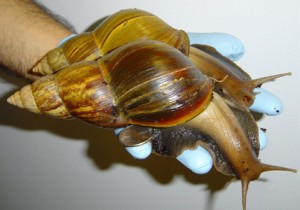I wrote a post a couple of weeks ago about Burmese pythons and other giant constrictors now living wild in Florida. Thousands of them are successfully breeding there. I got a lot of pingbacks from that post, mostly from indignant owners of giant constrictors.
As you probably know, introduced and invasive plants and animals are everywhere in the U.S. In one county park near my home in North Carolina, 35% of the plant species are nonnative – so I’m told by a professional botanist who frequents the park.
Florida is vulnerable
Florida is particularly susceptible to invasion by nonnative species because of its subtropical climate, and because of the number of people and shipments coming in from the Caribbean and Latin America. One invader that has been in the news lately, as a major plant pest and potential public health threat, is the giant African snail Achatina fulica. Its maximum size is 8 inches long and 4.5 inches wide – one of the world’s largest land snails. One pair of mated adults can lay 1,200 eggs per year.
A child brought 3 of the snails into the Miami area as pets in 1966, and his grandmother later released them into her garden. By 1973, those three had spawned a population of 18,000 snails. The government spent $1 million over the next decade trying to get rid of them. The snails are still popular as pets.
They eat citrus crops, can carry human diseases
Mark Fagan, a spokesman for Florida Dept of Agriculture and Consumer Services says the main concern is damage to agricultural crops. The snails can eat at least 500 types of plants, including citrus crops. They are known to carry a parasite, rat lungworm, that can cause serious diseases such as meningitis in humans. According to the University of Georgia website , these diseases can be transferred to humans by eating raw, undercooked infected snail meat or contaminated vegetables. Vegetables can become contaminated if the snails move across them.
The snails also eat stucco and plaster for minerals to grow their shells, damaging homes and other buildings.
Snails found in Hialeah, Florida
These giant African snails were thought to be eradicated in Florida, although present on Caribbean islands. But they have recently resurfaced in Florida, says Fagan. Multiple snails were found last month in Hialeah, Florida.
In addition to their large size, the snails can be recognized by having 7 to 9 spirals and a brownish shell that covers half the body. If you see these snails in your area, call your local department of agriculture.
Sources:
Anthony Colarossi. “Florida targets giant African snails.” Orlando Sentinel. Colarossi’s article appeared in the Charlotte Observer March 22, 2010.
University of Georgia College of Agricultural and Environmental Sciences






